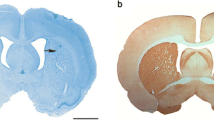Abstract
Experimental depletion of dopaminergic striatal neurons was induced in mice with the neurotoxin MPTP. To investigate a possible effect of nerve growth factor on the damaged neurons, we injected 4 μg into the right cerebral ventricle of mice three days after the last administration of MPTP. We found a significant increase of dopamine and homovanillic acid in the striatum of MPTP treated mice after NGF administration when compared with dopamine and HVA levels in MPTP-treated control mice (p<0.001). The increase of dopamine and homovanillic acid seems to be related to a partial restorative effect of NGF on the damaged dopaminergic cells, since ventricular administration of NGF to normal mice did not increase dopamine or homovanillic acid contents above the levels measured in untreated controls. It appears that administration of nerve growth factor prcduces a beneficial effect on damaged dopaminergic neurons; this effect could be due to stimulation of neuron sprouting from neurons that survived the toxic effect of MPTP. The increase of dopamine levels was seen 8 days after injection of nerve growth factor and was maintained at least until day 25, showing a lasting persistence of the restorative effect.
Similar content being viewed by others
References
Heikkila, R. E., Cabbat, F. S., Manzino, L., and Duvoisin, R. C., 1984. Effects of 1-methyl-4-phenyl-1,2,5,6-tetrahidropyridine on neostriatal dopamine in mice. Neuropharmacology 23:711–713.
Hallman, H., Lange, J., Olson, L., Strömberg, I., and Jonsson G., 1985. Neurochemical and histochemical characterization of neurotoxic effects of 1-methyl-4-phenyl-1,2,3,6-tetrahydrophyri-dine on brain catecholamine neurons in the mouse. J. Neurochem. 14:117–127.
Heikkila, R. E., Manzino, L., Cabbat, S. F. and Duvoisin, C. R. 1984. Protection against the dopaminergic neurotoxicity of 1-methyl-4-phenyl-1,2,5,6-tetrahydropyridine by monoamine oxidase inhibitors, Nature 311:467–469.
Hitchcock, E. R., Clough, C., Hughes, R. and Kenny, B., 1988. Embryos and Parkinson's disease, Lancet I:1274.
Goetz, C., Olanow, C. W., Koller, W. C., Penn, D. R., Cahill, D., Morantz, R., Stebbins, G., Tanner, M. C., Klawans, L. H., Shannon, M. K., Comella, L. C., Witt, T., Cox, C., Waxman, M. and Gauger, L., 1989. Multicenter study of autologous adrenal medullary transplantation to the corpus striatum in patients with advanced Parkinson's disease. N. Engl. J. Med. 320:337–341.
Lindvall, O., Rehncrona, S., Brundim, P., Gustavii, B., Asted, B., Widner, H., Lindholm, T., Björklund., Leenders, K. L., Rothwell, C. J., Frackowiak, R., Marsden, D., Johnels, Bo., Steg, G., Freedman, R., Hoffer, J. B., Seiger, A., Bygdeman, M., Strömberg I., and Olson, L., 1989. Human fetal dopamine neurons grafted into the striatum in two patients with severe Parkinson's disease, Arch. Neurol. 46:615–631.
Williams, A., 1990. Cell implantation in Parkinson's disease, British Med. J. 301:301–302.
Rosenberg, B. M., Friedmann, T., Robertson, R. C., Tuszynski, M., Wolff, J. A., Breakefield, S. O. and Gage, F. H., 1988. Grafting genetically modified cell to the damaged brain: Restorative effects of NGF expressions, Science 243:1575–1578.
Kromer F. L., 1988. Nerve growth factor treatment after brain injury prevents neuronal death, Science 235:214–126.
Ernfors, P., Ebendal, T., Olson, L., Mouton, P., Stromberg, I. and Persson, H., 1989. A cell line producing recombinant nerve growth factor evokes growth responses in intrinsic and grafted central cholinergic neurons, Proc. Natl. Acad. Sci. USA. 86:4756–4760.
Stromberg, I., Wetmore, C. J., Ebendal, T., Ernforns, P., Persson, H., and Olson, L. 1990. Rescue of basal forebrain cholinergic neurons after implantation of genetically modified cells producing recombinant NGF, J. Neurosci. Res. 25:405–411.
Kamegai, M., Niijima, K., Kunishita, T., Nishizawa, M., Ogawa, M., Araki, M., Veki, A., Konish, Y. and Tabira T. 1990. Interleukin 3 as a trophic factor for central cholinergic neurons in vitro and in vivo. Neuron 4:429–436.
Hama, T., Miyamoto, M., Tsukui, H., Nishio, C., and Hatanaka, H., 1989. Interleukin-6 as a neurotrophic factor for promoting the survival of cultured basal forebrain cholinergic neurons from postnatal rats. Neurosci. Lett. 104:340–344.
Hoter, M. M. and Barde, Y. A. 1988. Brain-derived neurotrophic factor prevents neural death in vivo. Letters Nature 331:261–262.
Müller, H. W., Beckh, S. and Seirfert, W. 1984. Neurotrophic factor for central neurons. Proc. Natl. Acad. Sci. 81:1248–1252.
Houlgatte, R., Mallat, M., Brachet, P. and Prochiantz, A. 1989. Secretion of nerve growth factor in cultures of glial cells and neurons derived from different regions of the mouse brain. J. Neurosci. Res. 24:143–152.
McIlwain, H., Bachelard, H. S. 1985. Biochemistry and the Central Nervous System, 5th edn., Churchill Livingston, New York.
Haley, T. J., and McCormic W. G., 1956. Pharmacological effects produced by intracerebral injection of drugs in the conscious mouse. Brit. J. Pharmacol. 12:12–15.
Glowniski, J. and Iversen, L. 1966. Regional studies of catecholamines in the rat brain. Disposition of H-DOPA in various regions of the brain. J. Neurochem. 13:655–669.
Diggory, G.L. and Buckett, W.R. 1984. An automated method to measure monamines and metabolites using elevated temperature reversed phase HPLC with electrochemical detection. Application to striatal dopamine and hippocampal serotonin turnover. J. Pharmacol. Methods. 11:207–217.
Otto, D. and Unsicker, K. 1990. Basic FGF reverses chemical and morphological deficits in the nigrostriatal system of MPTP-treated mice, J. Neurosci. 10:1912–1921.
Steel, R. G. D. and Torrie, J. H. 1966. Principles and procedures of statistics. New York, McGraw-Hill.
Author information
Authors and Affiliations
Rights and permissions
About this article
Cite this article
Garcia, E., Rios, C. & Sotelo, J. Ventricular injection of nerve growth factor increases dopamine content in the striata of MPTP-treated mice. Neurochem Res 17, 979–982 (1992). https://doi.org/10.1007/BF00966824
Accepted:
Issue Date:
DOI: https://doi.org/10.1007/BF00966824




